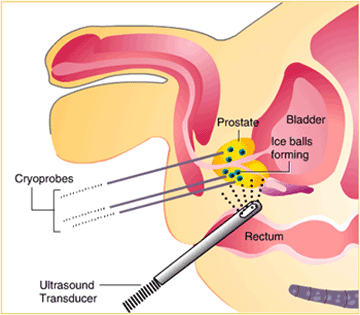Cryoablation
 Cryoablation or cryotherapy, is a minimally invasive treatment that uses extreme cold to freeze and destroy diseased tissue, including cancer cells.
Cryoablation or cryotherapy, is a minimally invasive treatment that uses extreme cold to freeze and destroy diseased tissue, including cancer cells.
During cryoablation, liquid nitrogen or argon gas is applied to diseased cells located outside or inside the body. Physicians use image-guidance techniques such as ultrasound, computed tomography (CT) or magnetic resonance (MR) to help guide these freezing substances to treatment sites located inside the body
Cryotherapy is also being used to treat tumors in other parts of the body, such as the kidneys, bones (including the spine), lungs, and breasts (including benign breast lumps called fibroadenomas). Although further research is needed to determine its long term effectiveness, cryotherapy has been shown to be effective in selected patients) (Generic Cialis).
How is does cryoablation destroy the cancer cells?
Cryotherapy applies nitrogen or argon gas at extremely cold temperatures to destroy diseased tissue. To destroy diseased tissue located outside the body, liquid nitrogen is applied directly with a cotton swab or spray device. For tumors located below the skin surface and deep in the body, the physician will use image-guidance to insert one or more applicators, or cryoprobes, through the skin to the site of the diseased tissue and then deliver liquid nitrogen or argon gas. Living tissue, healthy or diseased, cannot withstand extremely cold conditions and will die from:
-
ice formation in the fluid outside cells, which results in cellular dehydration.
-
ice formation within the cell. At approximately -40?C (-40?F) or less, intracellular lethal-ice crystals begin to form and will destroy almost any cell.
-
bursting from both swelling caused by ice expansion inside the cell or shrinking caused by water exiting the cell.
-
loss of blood supply. Cells die when their blood supply is choked off by ice forming within small tumor vessels, causing clotting.
Since the average blood-clotting time is approximately 10 minutes, the extreme cold is maintained for at least 10-15 minutes to assure unless tumor temperatures indicate that lethal-ice temperatures have been reached. Because cryotherapy consists of a series of steps that lead to cell death, tumors are repeatedly frozen and thawed; typically two freeze-thaw cycles are used. Once the cells are destroyed, the white blood cells of the immune system work to clear out the dead tissue. There is some evidence to suggest that this procedure also stimulates the immune system to attack remaining cancer cells.
It is always important to follow all directions provided by the doctor and continue to visit your doctor as scheduled.
?
